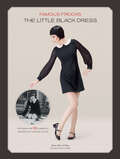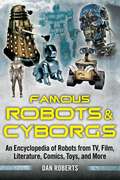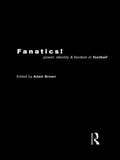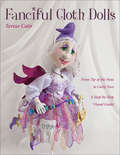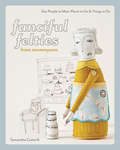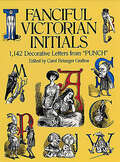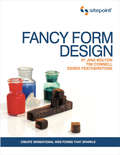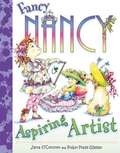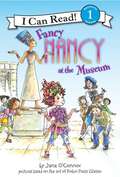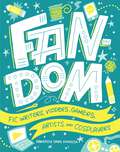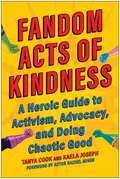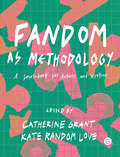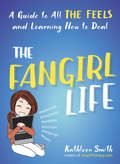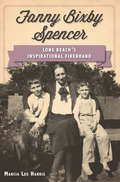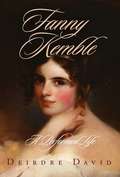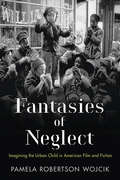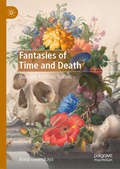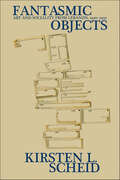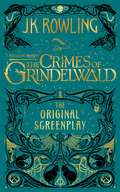- Table View
- List View
Famous Frocks: The Little Black Dress
by Dolin Bliss O'SheaCoco Chanel, Audrey Hepburn, Grace Kelly. . . . Each of these women had an influential take on the most classic wardrobe staple of all: the Little Black Dress. In this chic sewing book, patternmaker Dolin Bliss O'Shea pulls inspiration from famous LBDs throughout history--including Mary Quant's mod mini, a classic wrap dress worn by Liza Minelli, Princess Diana's smart A-line, and more--and offers patterns for reinterpreted versions that are perfectly stylish. Including 10 full dress patterns with sewing variations to make 20 garments in all, a primer on sewing techniques, vintage photographs of style icons, and full-color shots of the finished pieces, this book has everything fashionistas need to bring timeless style right into their closets.
Famous Robots and Cyborgs: An Encyclopedia of Robots from TV, Film, Literature, Comics, Toys, and More
by Dan RobertsFamous Robots and Cyborgs is a high-octane voyage through the history of our metallic friends and foes. Dan Roberts narrates the history, strengths, weaknesses, quirks, and foibles of a plethora of fictional robots, cyborgs, and mechanical races-taking in the pronouncements of sci-fi visionaries and eminent robotics scientists along the way. Roberts guides us through the evolution of the deadly Cylons of Battlestar Gallactica in its various forms to movie classics like the mysterious Gort of The Day the Earth Stood Still, the iconic C-3PO, and of course the Terminator.We encounter crazed cybernetic killers, megalomaniac computers, living spaceships, beautiful androids, human brains in metal bodies, and ultracompetitive robot gladiators. Along the way, find answers to such questions as: Are robots capable of love? Which were the least convincing and most laughable movie robots of all time? Can robots harm humans to save themselves? And can you really destroy a deadly cyborg assassin with the force of an exploding oil tanker?Famous Robots and Cyborgs is a joyful, eclectic, informative, celebratory journey through the hi-tech world of the mechanical man (and woman). Packed full of trivia, robo-facts, controversy, history, and information on robot toys, games, films, TV, and books, it will delight the dedicated robot aficionado and the interested newcomer alike.
Fanatics: Power, Identity and Fandom in Football
by Adam BrownEmbracing studies of football fans across Europe, this book tackles questions of power, national and regional identities, and race and racism, highlighting the changing role of fans in the game. Combining new approaches to the study of fan culture with critical assessments of the commercialization of the game, this fascinating book offers a comprehensive and timely examination of the state of European football supporters culture as the game prepares itself for the next millennium. The contributors, all leading figures in sports studies, consider: * whether football remains the peoples game, or if it is now run entirely by and for club owners and directors who have overseen the flotation of clubs on the stock exchange, a new focus on merchandising and the escalation of players salaries* the role of FIFA and UEFA in the struggle for control of world football* manifestations of racism and extreme nationalism in football, from the English medias xenophobic coverage of Euro 96 to the demonisation of Eric Cantona* media representations of national identity in football coverage in Germany, France and Spain * the interplay of national, religious and club identities among fans in England, Scotland, Ireland, Portugal and Scandinavia* the role of the law in regulating football * the future for supporters at a time when watching the match is more likely to mean turning on the television than going to a football ground.
Fanciful Cloth Dolls: From Tip of the Nose to Curly Toes: Step-by-Step Visual Guide
by Terese CatoThe self-taught designer guides you through creating enchanting heirlooms—including a tooth fairy, pincushion girls, an elf, and a tiny flower sprite. You don’t have to be a doll maker to enjoy crafting these little sweethearts. If you love to craft and sew, you’ll have fun learning new techniques for creating a whimsical fairy, an impish elf, or a sweet pincushion girl. From fabric sculpting to face painting and all the finishing touches, every captivating detail of your doll will be appreciated for years to come. A charming gallery of variations for each project will inspire you to add distinctive character and personal flair to your creations. Create a special keepsake doll that your family will cherish for generationsEach of the four projects has complete head-to-toe instructions, including details for expressive faces, perfect hair, cute clothes, and an abundance of accessoriesPerfect for both beginner and experienced doll enthusiasts—learn the basics, try new techniques, and sprinkle in your own unique embellishment style
Fanciful Felties from MummySam: Sew People to Meet, Places to Go & Things to Do
by Samantha Cotterill&“A darling array of characters to create out of wool felt, cotton fabrics, embroidery floss and stuffing . . . the little people make wonderful gifts.&”—Small Town Living An award-winning picture book author and illustrator, &“Samantha [aka mummysam] has turned her quirky and clever drawings into the dearest of little felt playthings/art objects&” (whipup.net). You&’ll love these charming softies with European flair. Make your own story with uptown sophisticates or down country folks. Add a brownstone, a cottage, or even a double-decker bus and a London phone booth to give your little people plenty of places to go and things to do! &“I&’ve long been a fan of Samantha&’s work, combining free motion embroidery and hand-sewn elements to make whimsical creations. This book features 14 artistic softies with instructions and templates to make them yourself. I love the way each project is photographed with a hand-drawn background, pulling us into Samantha&’s world of quirky characters and interesting objects.&”—The Long Thread &“Oh my! the cuteness is killing me . . . From groovy cars, to chic ladies about town, school boys and bunny rabbits and village houses—you have all the ingredients for lots of afternoons of imaginary play.&”—whipup.net
Fanciful Stitches, Colorful Quilts: 11 Easy Appliqué Projects to Embroider by Hand
by Laura WasilowskiDiscover how to create stunning appliqué quilts with these easy-to-follow projects from the author of Joyful Stitching.Laura shows quilters how to make bright, cheerful fused applique quilts. Along the way, she shares 17 different hand stitches that add unique color and dimension, that help the quilter tell a story with each design. The small, take-along size of these projects makes them perfect for your classes or clubs.• 11 fun and easy projects-make an assortment of whimsical houses with full-size templates• Take your art quilts to the next level by hand quilting and embellishing in one step• Learn how to make wavy bindings
Fanciful Victorian Initials: 1,142 Decorative Letters from "Punch" (Dover Pictorial Archive)
by Carol Belanger GraftonRich compendium of capital letters selected from venerable British humor magazine. Astonishing wit, invention, draughtsmanship in letters drawn by Tenniel, Leech, Sambourne, Doyle, other Victorian masters. Historic calligraphy; topical, political, literary allusions; animals, plants, many other motifs. All copyright-free. Inexhaustible graphic inspiration.
Fancy Dresses Described: A Glossary of Victorian Costumes
by Ardern HoltThe Victorians adored fancy-dress parties: what better way to escape the rigidity of social conventions than to spend a festive evening disguised as Cleopatra, a Swiss milkmaid, or Alice in Wonderland? Well-to-do party-goers of the era consulted Fancy Dresses Described, an elaborate guide to hundreds of glorious costumes. The book was so popular that it was updated several times; this is the sixth and final edition, originally published in 1896. Time has transformed it into an important historical document as well as an abundant cosplay resource. Twenty color and 40 black-and-white illustrations enhance the alphabetical entries, which are mostly for women's costumes but include a section on children's dress. Costumes range from the peasant garb of Austria, Italy, and Ireland to the finery of the six wives of Henry VIII, Marie Antoinette, and other members of French and English royalty. Additional entries spotlight characters from Shakespeare and Dickens; traditional apparel of Egypt and ancient Greece and Rome; Cinderella, Maid Marian, and other folkloric figures; as well as outfits suggested by astronomy, the seasons, the animal kingdom, and other thematic subjects. Costume designers, reenactors, lovers of Victorian fashion, and Halloween enthusiasts will find this historic volume a tremendous source of inspiration.
Fancy Form Design: Create Sensational Web Forms That Sparkle (Sitepoint Ser.)
by Jina Bolton Derek Featherstone Tim ConnellForms' - is there any other word that strikes as much fear into the hearts of web designers? Not any more ...Fancy Form Design is a practical hands-on, full color book that follows the process of creating visually stunning yet usable web forms, from start to end. The book covers all design elements from planning the form's purpose and interface through to mastering markup, applying style with CSS, and adding interactivity and visual effects with JavaScript. By the end of the you'll will have the code, and wisdom, they need to build fancy forms of their own.
Fancy Nancy: Aspiring Artist (I Can Read!)
by Jane O'ConnorIt's spring vacation and Fancy Nancy is feeling glum because her best friend Bree, is out of town. Luckily, it's Nancy's mom to the rescue! She brings home a brand new set of glitter markers. Nancy puts her trademark flair to tres creative use and devotes herself to becoming a serious artist (or artiste, as the French say). After all, everything about being an aspiring artist is fancy, fancy, fancy--especially when inspiration strikes!
Fancy Nancy at the Museum (I Can Read! #Level 1)
by Jane O'ConnorNancy's class is going on a trip to the museum, and Nancy wants to be extra fancy for the occasion. After a bumpy bus ride, she doesn't feel very well. Luckily for Nancy, her teacher, Ms. Glass, has a few fancy tricks of her own. Nothing can keep Nancy from making this trip magnifique! (That's a fancy French word for great!)
Fandom: Fic Writers, Vidders, Gamers, Artists, and Cosplayers
by Francesca Davis DiPiazzaHave you ever finished a book or TV series and wished for more? Created stories, art, or videos based on a game? Dressed up as your favorite character? If so, you've entered fandom. Fan writers expand and mix up stories, like sending the Star Trek crew to Hogwarts. Cosplayers sew Star Wars and Sailor Moon costumes, and fan filmmakers make music video tributes. Fans also enrich invented worlds with greater diversity, creating female and multiracial avatars for games peopled only with white male characters. Tour fandom's history and meet fan writers, video-makers, artists, costumers, and gamers who celebrate the things they love and shape fan communities online and in real life.
Fandom Acts of Kindness: A Heroic Guide to Activism, Advocacy, and Doing Chaotic Good
by Tanya Cook Kaela JosephFandom can save the world! This first of its kind, actionable and inspirational resource provides the tools and motivation necessary for pop culture fans to make a difference—while having fun! Fandoms are united as a community because of the power of story. And it&’s exactly the magical alchemy forged when mixing story and community that has helped fandoms across the world feed thousands of hungry children, donate countless books, build schools, register voters, disrupt online hate speech, and save lives through crafting PPE for COVID-19 frontline workers, natural disaster response, and mental health crisis support. Fandom Acts of Kindness not only tells the stories of the good fans have done in the world but serves as a dungeon master&’s guide to how to be a hero yourself. Perfect for those who want to inspire others, organize collective action, sustain, and nurture your own mental health and creativity, and do it all through a pop culture perspective.
Fandom as Methodology: A Sourcebook for Artists and Writers (Goldsmiths Press Ser.)
by Catherine Grant Kate Random LoveAn illustrated exploration of fandom that combines academic essays with artist pages and experimental texts.Fandom as Methodology examines fandom as a set of practices for approaching and writing about art. The collection includes experimental texts, autobiography, fiction, and new academic perspectives on fandom in and as art. Key to the idea of “fandom as methodology” is a focus on the potential for fandom in art to create oppositional spaces, communities, and practices, particularly from queer perspectives, but also through transnational, feminist and artist-of-color fandoms. The book provides a range of examples of artists and writers working in this vein, as well as academic essays that explore the ways in which fandom can be theorized as a methodology for art practice and art history. Fandom as Methodology proposes that many artists and art writers already draw on affective strategies found in fandom. With the current focus in many areas of art history, art writing, and performance studies around affective engagement with artworks and imaginative potentials, fandom is a key methodology that has yet to be explored. Interwoven into the academic essays are lavishly designed artist pages in which artists offer an introduction to their use of fandom as methodology.ContributorsTaylor J. Acosta, Catherine Grant, Dominic Johnson, Kate Random Love, Maud Lavin, Owen G. Parry, Alice Butler, SooJin Lee, Jenny Lin, Judy Batalion, Ika Willis.Artists featured in the artist pages Jeremy Deller, Ego Ahaiwe Sowinski, Anna Bunting-Branch, Maria Fusco, Cathy Lomax, Kamau Amu Patton, Holly Pester, Dawn Mellor, Michelle Williams Gamaker, The Women of Colour Index Reading Group, Liv Wynter, Zhiyuan Yang
The Fangirl Life: A Guide to All the Feels and Learning How to Deal
by Kathleen SmithAre You a Fangirl? * Do you survive boring classes or meetings by imagining your favorite TV couple making out? * Have you posted a lengthy diatribe on the Internet defending a fictional character? * Have you gotten carsick from reading fan fiction on your smartphone? * Has Netflix presented you with the "Are you still watching?" button at least once? If you answered yes, you are a fangirl. (But you already knew that!)Fangirling is more than a hobby; it's a way of life for an enormous community. As a fangirl, you are a passionate, intelligent, and creative creature. But sometimes focusing on the fictional can keep you from putting those qualities to use in your everyday life. Rather than using your pop culture obsessions to avoid your real-life problems, you can tackle issues like stress, anxiety, and low self-esteem by turning obsession into inspiration. If you enjoy flailing over badass fictional ladies or speculating endlessly over plot points, but would like to carve more space for the narrative of your own life, this is the book for you. Written by a proud fangirl who is also a licensed therapist, The Fangirl Life is a witty guide to putting your passions to use in your offline life, whether it's learning how writing fan fiction can be a launching point for greater career endeavors, or how to avoid the myths that fictional romance perpetuates.If you're ready to start translating those fictional obsessions into some bold personal moves, let The Fangirl Life help you become your own ultimate fangirl.From the Trade Paperback edition.
Fangoria's 101 Best Horror Movies You've Never Seen
by Adam LukemanA FEAST OF FRIGHTFUL FLICKS WAITING TO BE REDISCOVEREDAs the leading name in the world of horror, Fangoria magazine has been the source of information for fans of fright flicks for more than twenty years--covering feature films, video games, comic books, collectibles, and all aspects of horror entertainment. Working closely with Fangoria's experts, including Editor in Chief Anthony Timpone, Adam Lukeman has compiled a must-have guide for casual horror fans and hardcore horror junkies with Fangoria's 101 Best Horror Films You've Never Seen. With a brief synopsis for each of the included films, lists of cast and crew, "Terror Trivia," and little-known facts about these lesser-known but must-see gems, Fangoria's 101 Best Horror Films You've Never Seen offers a feast of gruesome information. Featured here are flicks that were dumped by their distributors or were initially flops, like Cherry Falls, Manhunter, and Pumpkinhead, foreign winners such as Cronos, The Vanishing, and Funny Games, and straight-to-video sleepers waiting to be discovered, including Shadowbuilder, Jack Be Nimble, and Nomads. There are even surprise entries directed by industry giants--movies like George A. Romero's Day of the Dead, Brian De Palma's Sisters, or Dario Argento's Opera--that are frequently overshadowed by the filmmakers' other, better-known works but are worthy of further examination. Entertaining and informative, Fangoria's 101 Best Horror Movies You've Never Seen offers more than a hundred reasons to look beyond the often ho-hum Hollywood hype fests . . . when you're really in the mood to feel your flesh crawl.From the Trade Paperback edition.
Fanny Bixby Spencer: Long Beach's Inspirational Firebrand
by Marcia Lee HarrisThe last daughter born to Jotham Bixby, the "Father of Long Beach," Fanny Bixby Spencer (1879-1930) carved her own singular and eccentric path across California history. Born to wealth and power, she chose a boldly independent, egalitarian lifestyle in an age when women's lives were largely confined to domesticity. Fanny served with the Long Beach Police Department as America's first policewoman. She was a founder of the city of Costa Mesa in Orange County. Her humanitarian efforts reached across ethnicities and social standing. Yet beyond her civic accomplishments, Fanny was provocative as a poet, artist, pacifist, suffragist, child advocate, foster mother and humanitarian. Marcia Lee Harris captures this fascinating woman's remarkable life, enhanced by Fanny's own poetry and soulful reflections.
Fanny Kemble
by Deirdre DavidA ForeWord magazine Book of the Year for 2007Charismatic, highly intelligent, and splendidly talented, Fanny Kemble (1809-93) was a Victorian celebrity, known on both sides of the Atlantic as an actress and member of the famous Kemble theatrical dynasty, as a fierce opponent of slavery despite her marriage to a wealthy slave owner, as a brilliantly successful solo performer of Shakespeare, and as the author of journals about her career and life on her husband's Georgia plantations. She was, in her own words, irresistible as a "woman who has sat at dinner alongside Byron . . . and who calls Tennyson, Alfred."Touring in America with her father in the early 1830s, Kemble impulsively wed the wealthy and charming Philadelphia bachelor Pierce Butler, beginning a tumultuous marriage that ended in a sensational divorce and custody battle fourteen years later. At the time of their marriage, Kemble had not yet visited the vast Georgia rice and cotton plantations to which Butler was heir. In the winter of 1838, they visited Butler's southern holdings, and a horrified Kemble wrote what would later be published on both sides of the Atlantic as Journal of a Residence on a Georgian Plantation. An important text for abolitionists, it revealed the inner workings of a plantation and the appalling conditions in which slaves lived. Returning to England after her divorce, she fashioned a new career as a solo performer of Shakespeare's plays and as the author of memoirs, several travel narratives and collections of poems, a short novel, and miscellaneous essays on the theater. For the rest of her life, she would divide her time between the two countries.In the various roles she performed in her life, on stage and off--abolitionist, author, estranged wife--Kemble remained highly theatrical, appropriating and subverting nineteenth-century prescriptions for women's lives, ever rewriting the roles to which she was assigned by society and inheritance. Hers was truly a performed life, and in the first Kemble biography in twenty-five years to examine that life in its entirety, Deirdre David presents it in all its richness and complexity.
Fantasies of Neglect
by Pamela Robertson WojcikIn our current era of helicopter parenting and stranger danger, an unaccompanied child wandering through the city might commonly be viewed as a victim of abuse and neglect. However, from the early twentieth century to the present day, countless books and films have portrayed the solitary exploration of urban spaces as a source of empowerment and delight for children. Fantasies of Neglect explains how this trope of the self-sufficient, mobile urban child originated and considers why it persists, even as it goes against the grain of social reality. Drawing from a wide range of films, children's books, adult novels, and sociological texts, Pamela Robertson Wojcik investigates how cities have simultaneously been demonized as dangerous spaces unfit for children and romanticized as wondrous playgrounds that foster a kid's independence and imagination. Charting the development of free-range urban child characters from Little Orphan Annie to Harriet the Spy to Hugo Cabret, and from Shirley Temple to the Dead End Kids, she considers the ongoing dialogue between these fictional representations and shifting discourses on the freedom and neglect of children. While tracking the general concerns Americans have expressed regarding the abstract figure of the child, the book also examines the varied attitudes toward specific types of urban children--girls and boys, blacks and whites, rich kids and poor ones, loners and neighborhood gangs. Through this diverse selection of sources, Fantasies of Neglect presents a nuanced chronicle of how notions of American urbanism and American childhood have grown up together.
Fantasies of Neglect: Imagining the Urban Child in American Film and Fiction
by Pamela Robertson WojcikIn our current era of helicopter parenting and stranger danger, an unaccompanied child wandering through the city might commonly be viewed as a victim of abuse and neglect. However, from the early twentieth century to the present day, countless books and films have portrayed the solitary exploration of urban spaces as a source of empowerment and delight for children. Fantasies of Neglect explains how this trope of the self-sufficient, mobile urban child originated and considers why it persists, even as it goes against the grain of social reality. Drawing from a wide range of films, children's books, adult novels, and sociological texts, Pamela Robertson Wojcik investigates how cities have simultaneously been demonized as dangerous spaces unfit for children and romanticized as wondrous playgrounds that foster a kid's independence and imagination. Charting the development of free-range urban child characters from Little Orphan Annie to Harriet the Spy to Hugo Cabret, and from Shirley Temple to the Dead End Kids, she considers the ongoing dialogue between these fictional representations and shifting discourses on the freedom and neglect of children. While tracking the general concerns Americans have expressed regarding the abstract figure of the child, the book also examines the varied attitudes toward specific types of urban children--girls and boys, blacks and whites, rich kids and poor ones, loners and neighborhood gangs. Through this diverse selection of sources, Fantasies of Neglect presents a nuanced chronicle of how notions of American urbanism and American childhood have grown up together.
Fantasies of Precision: American Modern Art, 1908-1947
by Ashley LazevnickRedefining the artistic movement that helped shape American modernism In the early decades of the twentieth century, a loose contingent of artists working in and around New York City gave rise to the aesthetic movement known as precisionism, primarily remembered for its exacting depictions of skyscrapers, factories, machine parts, and other symbols of a burgeoning modernity. Although often regarded as a singular group, these artists were remarkably varied in their subject matter and stylistic traits. Fantasies of Precision excavates the surprising ties that connected them, exploring notions of precision across philosophy, technology, medicine, and many other fields. Bookended by discussions of the landmark First Biennial Exhibition of Painting at the Whitney Museum in 1932, this study weaves together a series of interconnected chapters illuminating the careers of Charles Sheeler, Georgia O&’Keeffe, and Charles Demuth. Built on a theoretical framework of the writing of modernist poets Marianne Moore and William Carlos Williams, Fantasies of Precision outlines an &“ethos of precision&” that runs through the diverse practices of these artists, articulating how the broad range of enigmatic imagery they produced was underpinned by shared strategies of restraint, humility, and slowness. Questioning straightforward modes of art historical classification, Ashley Lazevnick redefines the concept that designated the precisionist movement. Through its cross-disciplinary approach and unique blend of historiography and fantasy, Fantasies of Precision offers a comprehensive reevaluation of one of the defining movements of artistic modernism.
Fantasies of the Master Race: Literature, Cinema and the Colonization of American Indians
by Ward Churchill M. Annette JaimesIn this volume of incisive essays, Ward Churchill looks at representations of American Indians in literature and film, delineating a history of cultural propaganda that has served to support the continued colonization of Native America. During each phase of the genocide of American Indians, the media has played a critical role in creating easily digestible stereotypes of Indians for popular consumption. Literature about Indians was first written and published in order to provoke and sanctify warfare against them. Later, the focus changed to enlisting public support for "civilizing the savages," stripping them of their culture and assimilating them into the dominant society. Now, in the final stages of cultural genocide, it is the appropriation and stereotyping of Native culture that establishes control over knowledge and truth.
Fantasies of Time and Death: Dunsany, Eddison, Tolkien
by Anna VaninskayaThis book reveals the unique contribution made by the three founding fathers of British fantasy—Lord Dunsany, E. R. Eddison and J. R. R. Tolkien—to our culture’s perennial reassessment of the meanings of time, death and eternity. It traces the poetic, philosophical and theological roots of the striking preoccupation with mortality and temporality that defines the imagined worlds of early fantasy fiction, and gives both the form of such fiction and its ideas the attention they deserve. Dunsany, Eddison and Tolkien raise some of the oldest questions in existence: about the limits of nature, human and divine; cosmic creation and destruction; the immortality conferred by art and memory; and the paradoxes and uncertainties generated by the universal experience of transience, the fear of annihilation and the desire for transcendence. But they respond to those questions by means of thought experiments that have no precedent in modern literary history.
Fantasmic Objects: Art and Sociality from Lebanon, 1920–1950 (Public Cultures Of The Middle East And North Africa Ser.)
by Kirsten L. ScheidIn Lebanon, the study of modern art—rather than power or hierarchy—has compelled citizens to confront how they define themselves as a postcolonial nation.In Fantasmic Objects, Kirsten L. Scheid offers a striking study of both modern art in Lebanon and modern Lebanon through art. By focusing on the careers of Moustapha Farrouk and Omar Onsi, forefathers of an iconic national repertoire, and their rebellious student Saloua Raouda Choucair, founder of an antirepresentational, participatory art, Scheid traces an emerging sense of what it means to be Lebanese through the evolution of new exhibition, pedagogical, and art-writing practices. She reveals that art and artists helped found the nation during French occupation, as the formal qualities and international exhibitions of nudes and landscapes in the 1930s crystallized notions of modern masculinity, patriotic femininity, non-sectarian religiosity, and citizenship. Examining the efforts of painters, sculptors, and activists in Lebanon who fiercely upheld aesthetic development and battled for new forms of political being, Fantasmic Objects offers an insightful approach to the history and formation of modern Lebanon.
Fantastic Beasts: The Crimes of Grindelwald - The Original Screenplay (Harry Potter)
by J. K. Rowling Mina Lima<p>J.K. Rowling's five-film Fantastic Beasts adventure series continues with the original screenplay for Fantastic Beasts: The Crimes of Grindelwald. <p>At the end of Fantastic Beasts and Where to Find Them, the powerful Dark wizard Gellert Grindelwald was captured in New York with the help of Newt Scamander. But, making good on his threat, Grindelwald escapes custody and sets about gathering followers, most unsuspecting of his true agenda: to raise pure-blood wizards up to rule over all non-magical beings. <p>In an effort to thwart Grindelwald's plans, Albus Dumbledore enlists Newt, his former Hogwarts student, who agrees to help once again, unaware of the dangers that lie ahead. Lines are drawn as love and loyalty are tested, even among the truest friends and family, in an increasingly divided wizarding world. <p>This second original screenplay from J.K. Rowling, illustrated with stunning line art from MinaLima, expands on earlier events that helped shape the wizarding world, with some surprising nods to the Harry Potter stories that will delight fans of both the books and films.</p>
